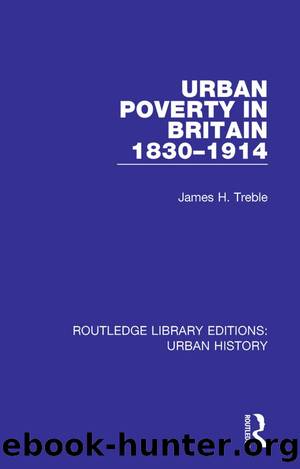Urban Poverty in Britain 1830-1914 by James H. Treble

Author:James H. Treble [Treble, James H.]
Language: eng
Format: epub
Tags: History, General
ISBN: 9781351172073
Google: DEMiEAAAQBAJ
Publisher: Routledge
Published: 2018-01-12T05:03:17+00:00
Liquor Consumption in the United Kingdom 1830-1914
(Quinquennial Periods)
Average yearly consumption of Spirits Average yearly consumption of Beer
Years Proof Gallons per capita Standard Gallons per capita
1830-4 1.11 21.6
1835-9 1.17 22.9
1840-4 0.87 19.5
1845-9 0.86 19.4
1850-4 1.08 21.1
1855-9 0.99 22.0
1860-4 0.87 24.6
1865-9 0.97 28.8
1870-4 1.14 31.1
1875-9 1.21 33.2
1880-4 1.05 29.2
1885-9 0.94 28.4
1890-4 1.00 29.8
1895-9 1.03 31.2
1900-4 1.04 30.2
1905-9 0.86 27.3
1910-14 0.67 27.0
Source: G.B. Wilson, Alcohol and the Nation (1940), p. 335.
In assessing the incidence of secondary poverty in society, however, it is more difficult to decide how far this pattern changed over time. At first glance the available statistics do not lend much support to the view that the Temperance Movement in its various guises had had, as late at 1914, a significant impact upon working-class drinking customs. Nevertheless those historians who have explored the problem in depth, have argued that by the 1870s ameliorative forces were at work in British society which acted as countervailing influences to drink. Harrison has listed changing consumer spending habits; the restrictions which, from the mid-1860s onwards, were placed in England and Wales upon week-day opening hours â the check in Scotland had come a decade earlier; the development of rail travel and, after 1870, the increased range of sporting activities open to the working classes as forces which made for greater sobriety, while Dingle has emphasised that the rise of the mass-market, trends in real earnings and by the early 1900s a more rational appraisal by the working man of the relationships between drink and living standards had a similar effect for much of the 1876-1914 period.105 Wilson, on the other hand, while laying stress upon the influence of positive forces operating in favour of a reduced consumption of alcohol, has also argued that, in this country, less socially beneficial habits, among them gambling and smoking, worked to promote the same end.106 Indeed, gambling itself was denounced as an undesirable social development among Middlesboroughâs iron workers by Lady Bell; as a contributing factor in the impoverishment of many girls in Londonâs mineral water factories who, according to O.C. Malvery, were known in the early 1900s to squander their earnings at the week-end upon horse racing; and by Rowntree as one of the principal routes to secondary poverty in York.107 Nor was the rise of professional football from the 1890s onwards seen in a more favourable light by some critics since it could again lead to advances in real income being frittered away. In the words of W.F. Anderson, Deputy Chairman of Glasgowâs Distress Committee,
I think there is a very big proportion of these people who spend their money foolishly on Saturday, not only in drink but on sport. They do not care how much they spend in going to a football match, and in taking a cab there, and in paying for a grand stand seat, and having a fish tea after it is all over. We could do better if we could inculcate a little thrift in them.108
Although this last verdict was wildly exaggerated even
Download
This site does not store any files on its server. We only index and link to content provided by other sites. Please contact the content providers to delete copyright contents if any and email us, we'll remove relevant links or contents immediately.
International Integration of the Brazilian Economy by Elias C. Grivoyannis(74848)
The Radium Girls by Kate Moore(11621)
Turbulence by E. J. Noyes(7700)
Nudge - Improving Decisions about Health, Wealth, and Happiness by Thaler Sunstein(7242)
The Black Swan by Nassim Nicholas Taleb(6764)
Rich Dad Poor Dad by Robert T. Kiyosaki(6176)
Pioneering Portfolio Management by David F. Swensen(6079)
Man-made Catastrophes and Risk Information Concealment by Dmitry Chernov & Didier Sornette(5647)
Zero to One by Peter Thiel(5489)
Secrecy World by Jake Bernstein(4388)
Millionaire: The Philanderer, Gambler, and Duelist Who Invented Modern Finance by Janet Gleeson(4094)
The Age of Surveillance Capitalism by Shoshana Zuboff(3985)
Skin in the Game by Nassim Nicholas Taleb(3965)
The Money Culture by Michael Lewis(3847)
Bullshit Jobs by David Graeber(3831)
Skin in the Game: Hidden Asymmetries in Daily Life by Nassim Nicholas Taleb(3723)
The Dhandho Investor by Mohnish Pabrai(3560)
The Wisdom of Finance by Mihir Desai(3524)
Blockchain Basics by Daniel Drescher(3329)
